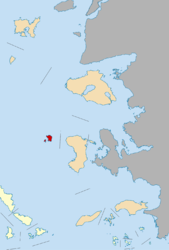Psara
|
Psara Ψαρά |
|
|---|---|

Psara, Agios Nikolaos monastery
|
|
| Coordinates: 38°33′N 25°34′E / 38.550°N 25.567°ECoordinates: 38°33′N 25°34′E / 38.550°N 25.567°E | |
| Country | Greece |
| Administrative region | North Aegean |
| Regional unit | Chios |
| Area | |
| • Municipality | 44.511 km2 (17.186 sq mi) |
| Highest elevation | 512 m (1,680 ft) |
| Lowest elevation | 0 m (0 ft) |
| Population (2011) | |
| • Municipality | 458 |
| • Municipality density | 10/km2 (27/sq mi) |
| Time zone | EET (UTC+2) |
| • Summer (DST) | EEST (UTC+3) |
| Postal code | 82x xx |
| Area code(s) | 22740 |
| Vehicle registration | ΧΙ |
| Website | www.dimospsaron.gr |
Psara (Greek: Ψαρά, Psará, Greek pronunciation: [psaˈra]; formerly known as Ψύρα, Psyra, or Ψυρίη, Psyriī) is a Greek island in the Aegean Sea. Together with the small island of Antipsara (Pop 4) it forms the municipality of Psara. It is part of the Chios regional unit, which is part of the North Aegean region. The only town of the island and seat of the municipality is also called Psara.
Psara had 448 inhabitants according to the 2011 census. It has a small port linking to the island of Chios and other parts of Greece.
Psara lies 44 nautical miles (81 km) northwest of Chios, 22 km (14 miles) from the northwestern point of the island of Chios and 150 km (93 mi) eastnortheast of Athens. The length and width are about 7 by 8 km (4 by 5 mi) and the area of the island is 43 square kilometres (17 sq mi). The highest point of the island is "Profitis Ilias" (512 metres (1,680 feet)). The municipality has an area of 44.511 km2.
The flag of Psara was designed by the Psariots and bears symbols of Filiki Eteria. It is made of white cloth bordered with red with a large red cross and the inscriptions of the name of the island "ΨΑ-ΡΑ" and the words Eleftheria i Thanatos (Liberty or Death) in capital red letters. The cross is standing on an upside down crescent, flanked on one side by a sword, on the other by a serpent killed by a bird. The flag was carried during the War of Independence by Psariot ships
An original flag of Psara, is preserved at the National Historical Museum of Greece
It has been inhabited since the Mycenaean period, its inhabitants relying on the sea to make a living as the island is treeless and rocky with little shrubbery. Homer first referred to the island as Psyra.
The islanders' sole source of livelihood has always been fishing, mainly for the locally abundant slipper lobsters, and shipping, with some tourist development in recent years.
...
Wikipedia


